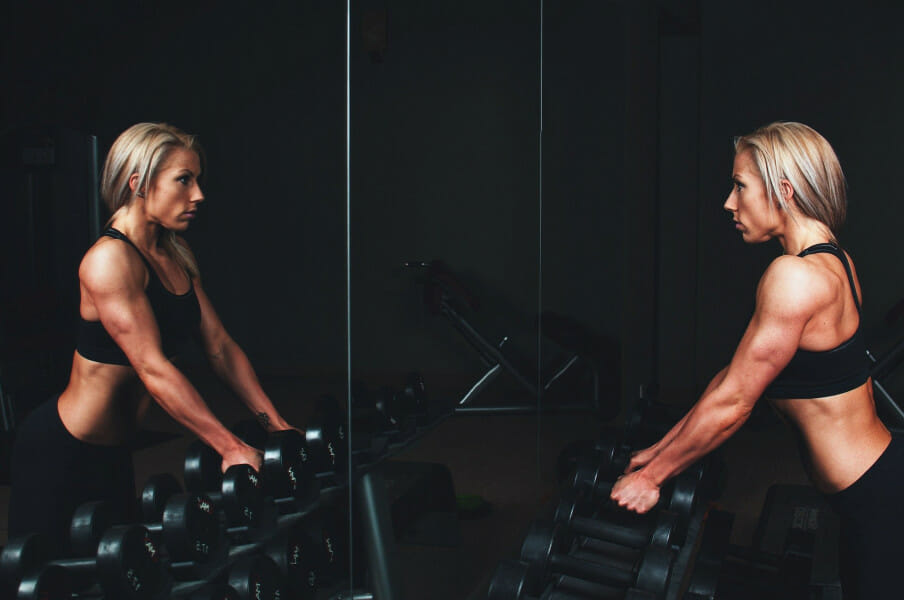A Complete Face Pull Exercise Can Save Your Body Posture
At first blush, the face pull exercise brings to mind one of those skin spas like Face Gym where you put your skin through the wringer and come out the other side with a perkier, happier complexion for it. And, well, that’s kind of the same when it comes to face pull exercises for shoulder strength.
“The face pull is a rear deltoid exercise,” says trainer and corrective exercise specialist Tatiana Lampa, NASM. “It’s an exercise everyone can do and you simply progress this exercise by adding weight.” Your rear delts are the back of your shoulders, but you’ll also feel this move in your trapezius (two large muscles that stretch from your shoulders down to the base of your rib cage) and the upper back. That means you’re working your entire posterior chain in just one, super-effective move. Woah.
What’s more, the face pull is a “functional movement,” which improves your daily life by helping your body naturally move better and smarter. Strong rear delts help those of us who sit at a desk all day maintain good posture. “Think about those rounded shoulders,” says Lampa. “We want to work on pulling the shoulders back,” says Lampa. “We focus on our back muscles—lats—a lot but sometimes people neglect the back of the shoulders which is a very important muscle to work.” Face pulls also help with a little something trainers and physical therapists call “scapular stability,” which helps you move your arms and shoulders more safely.
While almost anyone can reap the benefits of this trainer-favorite movement, those with shoulder or back problems should skip out on the exercise. If your body’s feeling up for it, here’s exactly how to give it a go.
How to perform the face pull exercise at home or at the gym
Normally, the face pull exercise is performed with the cable machine in the weight room, using the rope attachment. However, if you’re still not going to the gym (either because your local one hasn’t opened yet, or because you don’t feel safe going yet) you can use a band—like one of these—instead. If you’re choosing the DIY option, loop the band around a sturdy stair rail or tie a knot in the middle of the band and shut it into the top of a door to secure it in place.
Remember, this exercise gets harder the more weight you use—so start with either a lighter resistance band or a small amount of weight on your lat pull-down machine. This is the beginner version, but once you get stronger, you can begin adding weight and varying the exercise to make it more challenging.
Face pull exercise, step-by-step
Complete three to four sets of 10 to 12 reps, working in a superset if you so desire. You can pair this exercise with an arm-focused workout, or go ahead and incorporate into a full-body day that could also include deadlifts, squats, skull-crushers (sigh, if you wish), and so on.
1. Adjust the cable machine so it comes to about the height of your mid-chest.
2. Use an overhand grip to drag the bar until the wire goes taught (but you’re not lifting the weights, yet). At the point, your arms should be extended straight out in front of you.
3. Situate your feet so that you’re either in split stance position with one foot slightly ahead of the other, or keep your feet hips’ width apart. Choose whatever makes you feel the most stable here.
4. Squeeze your shoulder blades and shoot your elbows out to the sides without hiking your shoulders up to your ears.
5. Squeeze your shoulder blades and hold for a count of three seconds, then release back to the starting position carefully (try your best to not let it snap back into place, as this could hurt your back). Perform this exercise slowly to keep your body safe through all your repetitions.
Variation 1: Core-centric face pulls
This time, come to your knees and adjust the cable machine so it comes to about the height of your mid-chest. Lampa says that this teeny, tiny adjustment makes the move way more taxing on your core stability (which is also crucial for posture).
Variation 2: Flip your grip to improve your range of motion
Another option is to flip your grip so that your palms face up to the sky. This riff on the original move will help you learn how to stabilize your core and spine when you’re handling heavy things in your daily life. Just make sure to use lower weight and lower reps on this one.
Variation 3: Make the movement unilateral to focus on each arm more
Of course, there’s always the option of taking it one arm at a time with this one. This is called unilateral training, and it has been found to help exercise enthusiasts avoid injuries, build balanced muscle, and strengthen the body more quickly. To do that, use a cable machine attachment with only one rope or grab a single side of your resistance band
Long story short: The face pull exercise contains all the components of a fantastic functional movement that helps you live your life outside of your workout hour the way you want. Although it’s traditionally conducted with a cable machine at the gym, you can absolutely do it at home as long as you have resistance bands of various weights to hold onto for whatever workout you incorporate the move into. If you’re someone with back or shoulder issues, this is one to skip out on (and try these moves instead).














